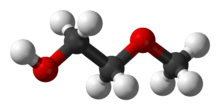2-Methoxyethanol
2-Methoxyethanol, or methyl cellosolve, is an organic compound with formula C
3H
8O
2 that is used mainly as a solvent. It is a clear, colorless liquid with an ether-like odor. It is in a class of solvents known as glycol ethers which are notable for their ability to dissolve a variety of different types of chemical compounds and for their miscibility with water and other solvents. It can be formed by the nucleophilic attack of methanol on protonated ethylene oxide followed by proton transfer:
- C
2H
5O+
+ CH
3OH → C
3H
8O
2 + H+
 | |
 | |
| Names | |
|---|---|
| IUPAC name
2-Methoxyethanol | |
| Other names
Ethylene glycol monomethyl ether EGME Methyl Cellosolve | |
| Identifiers | |
CAS Number |
|
3D model (JSmol) |
|
Beilstein Reference |
1731074 |
| ChEBI | |
| ChEMBL | |
| ChemSpider | |
| DrugBank | |
| ECHA InfoCard | 100.003.377 |
| EC Number |
|
Gmelin Reference |
81877 |
| KEGG | |
PubChem CID |
|
| RTECS number |
|
| UNII | |
| UN number | 1188 |
CompTox Dashboard (EPA) |
|
InChI
| |
SMILES
| |
| Properties | |
Chemical formula |
C3H8O2 |
| Molar mass | 76.09 g/mol |
| Appearance | Colorless liquid |
| Odor | Ether-like[1] |
| Density | 0.965 g/cm3 |
| Melting point | −85 °C (−121 °F; 188 K) |
| Boiling point | 124 to 125 °C (255 to 257 °F; 397 to 398 K) |
Solubility in water |
miscible[1] |
| Vapor pressure | 6 mmHg (20°C)[1] |
| Hazards | |
| Safety data sheet | External MSDS |
| GHS pictograms |    |
| GHS Signal word | Danger |
GHS hazard statements |
H226, H302, H312, H332, H360 |
GHS precautionary statements |
P201, P202, P210, P233, P240, P241, P242, P243, P261, P264, P270, P271, P280, P281, P301+312, P302+352, P303+361+353, P304+312, P304+340, P308+313, P312, P322, P330, P363, P370+378 |
| NFPA 704 (fire diamond) | 
2
3
2 |
| Flash point | 39 °C (102 °F; 312 K) |
| Explosive limits | 1.8%-14%[1] |
| Lethal dose or concentration (LD, LC): | |
LDLo (lowest published) |
2370 mg/kg (rat, oral) 890 mg/kg (rabbit, oral) 1480 mg/kg (mouse, oral) 950 mg/kg (guinea pig, oral)[2] |
LC50 (median concentration) |
1480 ppm (mouse, 7 hr)[2] |
| NIOSH (US health exposure limits): | |
PEL (Permissible) |
TWA 25 ppm (80 mg/m3) [skin][1] |
REL (Recommended) |
TWA 0.1 ppm (0.3 mg/m3) [skin][1] |
IDLH (Immediate danger) |
200 ppm[1] |
Except where otherwise noted, data are given for materials in their standard state (at 25 °C [77 °F], 100 kPa). | |
| Infobox references | |
2-Methoxyethanol is used as a solvent for many different purposes such as varnishes, dyes, and resins. It is also used as an additive in airplane deicing solutions. In organometallic chemistry it is commonly used for the synthesis of Vaska's complex and related compounds such as carbonylchlorohydridotris(triphenylphosphine)ruthenium (II). During these reactions the alcohol acts as a source of hydride and carbon monoxide.
2-Methoxyethanol is toxic to the bone marrow and testicles. Workers exposed to high levels are at risk for granulocytopenia, macrocytic anemia, oligospermia, and azoospermia.[3]
The methoxyethanol is converted by alcohol dehydrogenase into methoxyacetic acid which is the substance which causes the harmful effects. Both ethanol and acetate have a protecting effect. The methoxyacetate can enter the Krebs cycle where it forms methoxycitrate.[4]
References
- NIOSH Pocket Guide to Chemical Hazards. "#0401". National Institute for Occupational Safety and Health (NIOSH).
- "Methyl cellosolve". Immediately Dangerous to Life and Health Concentrations (IDLH). National Institute for Occupational Safety and Health (NIOSH).
- "Occupational exposure guidelines". Archived from the original on 2016-08-22. Retrieved 2014-03-28.
- F. Welsch, Toxicology Letters, 2005, volume 156, pages 13-28